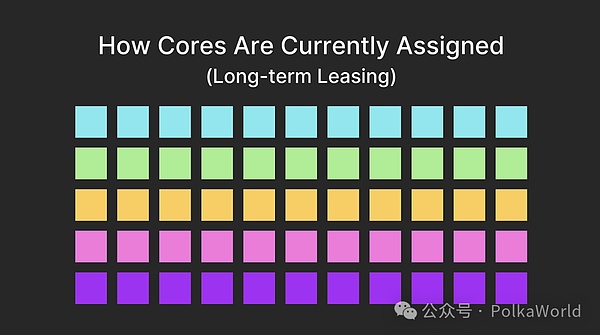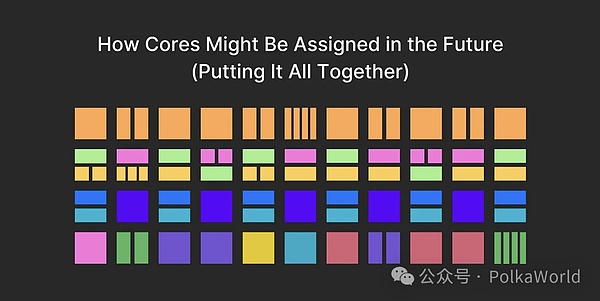Tanssi 在 Polkadot 2.0 中的角色
在去年哥本哈根的 Polkadot Decoded 大会上,Polkadot 的创始人 Gavin Wood 发表了关于 Polkadot 未来的重要主题演讲,这被称为 Polkadot 2.0。
这一新愿景旨在让 Polkadot 更接近以太坊最初的理念之一,即“世界计算机”,目标提供一种广泛的计算能力,这种计算能力不需要依赖于任何中心化的信任机制,同时保持系统的健壮性和安全性。
随着这一新方向,Polkadot 2.0 开启了一条新的道路,可以充分释放中继链及其平行链的力量和潜力!Polkadot 2.0 强调灵活性,特别是在分布式计算中,旧的一刀切模型已经过时。相反,Polkadot 2.0 支持多样化的计算环境,从临时性的链(可能用于短期或特定任务)和高容量链(能够处理大量的交易和数据)。同时还能利用 Polkadot 框架的固有优势,比如安全性、可扩展性和互操作性,来优化这些不同类型的链的性能和功能。
当前 Polkadot 的运作方式及改进机会
正如 Gav 所解释的,目前的模型起源于 2016 年,当时发布了第一份 Polkadot 白皮书。
分片,即将单一区块链分割成多个同质链的过程,在那时引起了显著关注。它被视为以太坊 2.0 的关键元素,并广泛被认为是解决可扩展性挑战的方案。然而,以太坊后来的路线图转向了基于 Rollup 的方法。
Polkadot 对基础的分片概念进行了改进,引入了灵活的异构分片,最终演变成了平行链。Polkadot 旨在促进一个环境,其中分片可以根据各种应用需求多样化,并使用 XCM(Polkadot 的跨链消息标准)的方式简化它们之间的通信。
在这个基础上,Polkadot 发展成为我们今天所看到的 Polkadot 1.0。然而,即使有了这些进步,Gavin Wood 也指出了当前架构中的某些问题:
不灵活的平行链拍卖模型,这种模型可能会阻碍小型创新者的参与,而更有利于资源更丰富的大团队。
将整个租约期间的所有“核心”资源分配给单个平行链,这导致效率低下。如果平行链的区块没有填满,验证者和团队将会浪费资源。
正如开发过程中经常发生的那样,最终产品可能与最初预期的不同。就像 Gav 所说的,“事实证明,当你构建它时,你会意识到你构建的东西与你最初试图做的东西完全不同。通常情况下,如果你很幸运或有一个很棒的团队支持你,你可以创造出比你最初构建的更好的东西。”
平行链是 Polkadot 愿景的焦点,但它们现在太 “ 链中心化 ” 了。
在设计和发展 Polkadot 2.0 的过程中,需要考虑到计算机科学中的两个重要概念:抽象和泛化。
Polkadot 2.0:使用弹性核心(Elastic Cores)来适应不同的计算需求
Polkadot 2.0 的主要创新在于改变了区块链生态系统中安全资源分配的方式。以往,每个平行链都被视为一个类似于 CPU 核心的单元,具有一定的计算能力。这种计算能力代表了该链能够承受的安全级别,就像一部智能手机的性能一样,有高有低。
然而,随着 Polkadot 2.0 的推出,我们将不再静态地为每个链分配一个核心。相反,我们正在采用一种弹性的、根据当前需求量身定制的安全资源的分配方式。

当前的核心是如何分配的
图片来源:Gav 在 Polkadot Decoded 2023 的 PPT
例如,应用链(Appchains)有时可能需要的吞吐量不足一个完整核心的吞吐量,因此它们会“跳过”几个区块,将它们让给其他用户。在其他情况下,它们可能会与多个应用链共享一个核心,或者在需求高时甚至需要同时使用多个核心来应对。

未来如何在 Polkadot 2.0 中分配核心
图片来源:Gav 在 Polkadot Decoded 2023 上的演讲
这种资源分配的适应性与“灵活/弹性核心”的概念相呼应。在这里,Tanssi 扮演了关键角色。Tanssi 简化了开发人员的工作流程,它让开发人员能够更方便地设计和实现适应弹性核心的应用程序。
丰富而安全的跨链互操作性:Polkadot 的新愿景
Polkadot 2.0 超越了独立的区块链,设想了一个更加互联和流动的区块链生态系统。Gavin 用一张餐巾纸的画来说明这一点,将现有的中继链 + 平行链模型与设想中的核心和应用程序“网状”连接进行了对比,这些核心和应用程序被归类到特定的领域中。这些领域保持它们的独特性以确保专业化,但现在它们被复杂地互联起来。

Gavin Wood 对 Polkadot 2.0 功能描述的草稿图
图片来源:Gav Wood 在 Polkadot Decoded 2023 上的演讲
为了增强这种互联性,Polkadot 2.0 正在推出一个经过改进的共识机制,增强了安全性、交易路由、平行链性能和整体用户体验。此外,为了促进不同领域之间的通信,“ Accords ” 已经被引入。Accords 在 XCM 模型的基础上更进一步,制定了一套共享的“法律”,定义了链间互动。
强调社区去中心化的重要性,Polkadot 2.0 的治理正向类似 DAO 的结构过渡,强调了社区在真正去中心化中不可或缺的作用。
从平行链到应用链到容器链:Tanssi 在 Polkadot 2.0 中的角色
展望 Polkadot 的未来,显然灵活性是核心。Polkadot 2.0 正在引入一个新的安全市场,标志着传统的平行链插槽竞拍的转变。这种变化让人想起熟悉的云平台,允许大公司和小团队根据需求灵活地选择资源。
在这个不断发展的格局中,Tanssi 作为应用链基础设施协议的重要性不容置疑。Polkadot 2.0,凭借其民主化的核心(Core)技术和降低的应用链启动成本,需要一个强大、用户友好的技术支撑 —— 这正是 Tanssi 所提供的。
想象一位开发者热衷于在应用链上引入一款新颖的金融应用。有了 Tanssi,那么他们就不需要过多地关注底层的基础设施,可以专注于设计他们独特的应用。Tanssi 的一个核心特性是容器链协议(ContainerChain protocol),它为应用链提供了现成的解决方案,用于区块生成、数据可用性、跨链消息传递和其他集成。这样的简化基础设施加快了部署时间表,从一个月的开发时间缩短到不到一小时。这种效率不仅有利于市场进入,还允许开发者有更多时间来完善他们的应用,增强用户体验,并培养活跃的用户社区。
总之,Tanssi 注定成为应用链开发的首选解决方案,就像游戏开发者偏爱 Unity 或 Unreal Engine 平台一样。它承诺提供一个无缝、高效和用户友好的体验,推动 Polkadot 2.0 实现更加互联和适应性的区块链生态系统的愿景。
我们什么时候能看到 Polkadot 2.0?
根据之前 Web3 基金会的 Joe 的分享,Coretime 将在 2024 Q1 在 Kusama 启动,2024 Q2 在 Polkadot 启动。目前我们已经看到 Coretime 已经在 Rococo 上开始销售!Polkadot 1.2 版本也将推出,最大的新增功能就是在 Kusama 上启动 Coretime!
最近我们也看到社区开始讨论 Coretime 的定价问题。在这里查看讨论《波卡 2.0 批量 Coretime 初始定价设置多少合适?》
还有一个激动人心的进展是,Polkadot Fellowship 已经投票通过了 74 号公投!这意味着在启动 Coretime 销售的时候,内置了收入的销毁
Polkadot 的开发从未停止,已经成功地解决了构建应用链的许多去中心化难题。去中心化的收集者、轻客户端、OpenGov —— 所有这些基础都是构建一个弹性(或不可阻挡)网络所必需的。
对于 Polkadot 2.0,重点将放在加速和支持下一个万亿美元级别的 Web3 应用案例上,Tanssi 将在这里帮助完成它的部分工作。
如果你想了解 Tanssi 如何革新应用链空间。关注 Tanssi 的最新动态,并在 Discord、Telegram 和 Twitter 上加入他们的社区。
At the conference in Copenhagen last year, the founder delivered an important keynote speech on the future, which was called this new vision, aiming to bring it closer to one of the original ideas of Ethereum, that is, the world computer goal, and provide a wide range of computing power, which does not depend on any centralized trust mechanism while maintaining the robustness and security of the system. With this new direction, a new road has been opened, and the power and potential of the relay chain and its parallel chain can be fully released, emphasizing flexibility. Especially in distributed computing, the old one-size-fits-all model is out of date. On the contrary, it supports a variety of computing environments. From temporary chains, it may be used for short-term or specific tasks and high-capacity chains, which can handle a large number of transactions and data, and at the same time, it can make use of the inherent advantages of the framework, such as security, scalability and interoperability, to optimize the performance and functions of these different types of chains. As explained, the current model originated in the year when the first white paper was released. The process of dividing a single blockchain into multiple homogeneous chains attracted remarkable attention at that time. It was regarded as a key element of Ethereum and widely regarded as a solution to the scalability challenge. However, the later roadmap of Ethereum turned to a method based on, improved the basic concept of fragmentation, introduced flexible heterogeneous fragmentation and finally evolved into a parallel chain, aiming at promoting an environment in which fragmentation can be diversified according to various application requirements and simplified in the way of cross-chain message standards. On this basis, the communication between the two companies has developed into what we see today. However, even with these advances, some problems in the current architecture have been pointed out. The inflexible parallel chain auction model may hinder the participation of small innovators and is more conducive to the large team with more resources to allocate all the core resources to a single parallel chain during the lease period, which leads to inefficiency. If the blocks of the parallel chain are not filled, the verifier and the team will waste resources, as often happens in the development process. As it turns out, when you build it, you will realize that what you build is completely different from what you originally tried to do. Usually, if you are lucky or have a great team to support you, you can create something better than what you originally built. Parallel chains are the focus of the vision, but they are now too centralized. In the process of design and development, two important concepts in computer science need to be considered: abstraction and universality. The main innovation of using elastic core to adapt to different computing needs is to change the way of allocating security resources in blockchain ecosystem. In the past, each parallel chain was regarded as a unit similar to the core, which has certain computing power. This computing power represents the security level that the chain can withstand, just like the performance of a smart phone. However, with the launch, we will no longer statically allocate a core to each chain. On the contrary, we are adopting an elastic basis. At present, the distribution method of tailored security resources is the core of how to distribute the pictures. For example, the application chain may sometimes need less throughput than a complete core, so they will skip several blocks and give them to other users. In other cases, they may share a core with multiple application chains or even use multiple cores at the same time when the demand is high to cope with how to distribute the core pictures in the future. The adaptability of collocation echoes the concept of flexible elastic core, which plays a key role here, simplifying the workflow of developers. It enables developers to design and implement applications that adapt to elastic core more conveniently. The new vision of rich and safe cross-chain interoperability transcends the independent blockchain and envisages a more interconnected and mobile blockchain ecosystem. Use a napkin to illustrate this point. The network connection is compared. These cores and applications are classified into specific fields, which keep their uniqueness to ensure specialization, but now they are intricately interconnected. The draft picture of functional description comes from the speech on the Internet. In order to enhance this interconnection, an improved consensus mechanism is being introduced to enhance the performance of security transaction routing parallel chain and the overall user experience. In addition, in order to promote communication between different fields, it has been introduced on the basis of the model. Further, a set of shared laws is formulated, which defines the interaction between chains, emphasizes the importance of community decentralization, and the governance is transitioning to a similar structure, emphasizing the indispensable role of communities in real decentralization, from parallel chain to application chain to container chain. Obviously, flexibility in the future is that the core is introducing a new security market, which marks the transformation of the traditional parallel chain slot auction. This change is reminiscent of the familiar cloud platform, which allows large companies and small teams to be flexible according to their needs. There is no doubt that the importance of choosing resources properly as an application chain infrastructure agreement in this developing pattern requires a strong user-friendly technical support with its democratic core technology and reduced application chain start-up cost. This is exactly the imagination provided. A developer is keen on introducing a novel financial application into the application chain, so they don't need to pay too much attention to the underlying infrastructure and can concentrate on designing a container, which is a core feature of their unique application. Chain protocol, which provides a ready-made solution for application chain, is used for block generation, data availability, cross-chain messaging and other integration. This simplified infrastructure speeds up the deployment schedule from one month's development time to less than one hour. This efficiency not only facilitates market entry, but also allows developers more time to improve their applications, enhance user experience and cultivate an active user community. In short, it is destined to become the first choice solution for application chain development, just like game developers prefer or flat. Like Taiwan, it promises to provide a seamless, efficient and user-friendly experience to promote the vision of a more interconnected and adaptive blockchain ecosystem. When can we see that according to the previous sharing of the foundation, it will be launched? At present, we have seen that the sales version has been launched on the Internet, and the biggest new function will also be launched. Recently, we have also seen the pricing problem that the community has begun to discuss. Here, we can check and discuss how appropriate the initial pricing setting of boca cards is. There is also an exciting development that we have voted for the referendum No.1, which means that the revenue sales are built in when the sales are started. 比特币今日价格行情网_okx交易所app_永续合约_比特币怎么买卖交易_虚拟币交易所平台
注册有任何问题请添加 微信:MVIP619 拉你进入群

打开微信扫一扫
添加客服
进入交流群
1.本站遵循行业规范,任何转载的稿件都会明确标注作者和来源;2.本站的原创文章,请转载时务必注明文章作者和来源,不尊重原创的行为我们将追究责任;3.作者投稿可能会经我们编辑修改或补充。

















